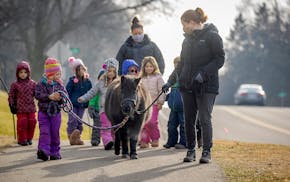The two-story elementary school stands alone, surrounded by snow-swept fields on the edge of Elko New Market.
Some of those fields were expected to sprout homes by now, according to expectations back when the school district built Eagle View Elementary two decades ago.
Situated just south of Lakeville on Interstate 35 and little more than a half-hour from the Twin Cities when there's no traffic, Elko New Market has been pegged for — and sometimes saddled with — great expectations for population growth. The Met Council and the city have even built expensive sewer and water facilities for a boom that hasn't materialized. Yet.
This month, the Metropolitan Council approved new population forecasts that again put Elko New Market on a trajectory for significant growth. Momentum for population growth has shifted from the central cities that boomed last decade to the suburbs and more distant small towns. Amid that shift, Elko New Market, population 5,200, is forecast to double to 10,500 people by 2050.
While the city has underperformed the Met Council's forecasts in the past, city officials say they think the new forecasts may be an undercount, and business owners say times have changed.
"This time it may indeed be different," said Bob Vogel, the chairman of New Market Bank's board.
Growth long forecast
Vogel grew up in New Market decades before it merged with Elko, and he has represented the area both on the Scott County Board and as a state representative. He has watched development spread beyond the three-block main drag where his grandfather built an earlier location of the bank.
For most of its history, Elko and New Market were rural towns with a few homes. Their businesses primarily served farm families who lived in the surrounding area. A railroad stop in Elko brought trains through, but the towns remained small.
That changed with the exurban boom late in the last century.
"It was a rural farming community and then sometime in the late '90s, it really started to grow," Vogel said.
Property in Lakeville got more expensive, and people learned they could trade an extra 5 minutes in commute time for an extra $30,000 in house, he said.
Two decades ago, the Met Council approved an extension of the regional sewer service to Elko and New Market. That decision was based on a strategy at the time to limit sprawl and the use of wells by centering development around rural cities — plus the strength of population forecasts.
The forecasts, compiled each decade with city input and updated along the way, help set the agenda for city and regional plans.
In 2005, Met Council forecasts estimated the Elko New Market area would have 13,000 people by 2020, and 20,800 people by 2030.
In 2007, Elko and New Market merged. The outlook for fast growth looked rosy as farm fields turned into housing developments, and the city's population was multiplying quickly.
Then, an unforeseen event: The Great Recession hit, bringing development to a relative standstill. Sewer systems installed to accommodate the elusive growth became a budget burden in Elko New Market and East Bethel, another fast-developing rural area on the northern edge of the metro.
Both cities got the Met Council to limit the amount they owed for sewer facilities' construction after the population growth that would have helped pay for the extension didn't come.
Elko New Market is still paying that off, but City Administrator Tom Terry said it's manageable.
"We're projected to, potentially, be a community of 70,000 to 80,000 in the long, long-term. That connection allows us to go there," he said.
Since the recession, Elko New Market has seen slow but steady population growth, reflected in amended Met Council population forecasts. But locals say there are signs the pace is changing.
Builders eye Elko New Market
The lunch crowd was trickling into the Firehouse Grille, one of a handful of restaurants in town, just before noon on a recent Friday. Owner Kate Timmerman, who is also on the City Council, said she's noticed a slight uptick in lunch customers, partly because of construction workers.
Across the street, national developer Lennar is building the new Ridgeview Heights community, which advertises new houses starting at $375,000.
"Honestly, you get more house for your buck down here than you do in the cities," Timmerman said.
She said people moving to Elko New Market are attracted to good schools, safe neighborhoods and the small-town feel she thinks the city will retain even as it grows.
"Everyone is there for each other and we help each other out," she said. "That's what community is about and that's why I love it down here."
The city's senior planner, Renee Christianson, said more change is coming, noting Lennar is one of three national developers eyeing Elko New Market.
"There's a couple of other nationals we're working with," she said. "We don't have their applications in yet, so I'm going to withhold those names, but they're big hitters right along with Lennar."
Terry also pointed to other factors that suggest growth, including longtime farms going up for sale.
"I think we are also in a position where there is more land available, from a practical standpoint in the community, than there has been for a while," Terry said.
Farther from the cities, closer to family
Paul and Peggy Hokeness moved to Elko New Market more than three years ago after selling their longtime home in Minneapolis' Fulton neighborhood.
Both grew up in small Minnesota towns — he in Northfield, she in Tyler. Now retired, Paul said they enjoyed the lakes and trails in the city but were growing tired of commotion and what felt like a rising tide of garage break-ins in their Minneapolis neighborhood.
"The traffic and the congestion and the commotion, and then they're tearing old houses down and building mansions, and it just did not feel right," he said.
They wanted to find someplace where they could look out their back windows and not see another house, Paul said. After looking around the south metro, where they could be closer to their grandkids in New Prague, they settled on Elko New Market.
They built a one-story, slab-on-grade house, where their view, depending on the day, might include deer or sandhill cranes.
After a career with the Minneapolis parks, Paul joined Elko New Market's Park Board. That's helped him meet people, but he still marvels at how friendly his neighbors are — many of them fellow retirees, others young families.
"The people that we're living around, we've gotten to know real quickly," he said. "And there's a new development, there are a lot of young families."
Small towns forecast to grow fast
The same forces at work in Elko New Market are also in play in other rural towns around the metro area that are starting to look more like suburbs. Several of these — including Belle Plaine, New Germany and Watertown — are forecast to be among the fastest growers.
"They've been just beyond the developing edge of the region‚" said Todd Graham, the Met Council's principal forecaster. As the growth swings from the urban core to the suburbs, he said, the development is moving out.
Some of the cities' growth is still limited by road access, sewer and other infrastructure and their own desire to stay small.
"A place like Scandia, Minnesota, is way in the far northeast of the region and does not want to be a suburb," Graham said.
Others, like Elko New Market, have embraced the idea of growth.
This time, the forecasts are a little more conservative, but city leaders and residents say the impending growth feels real. Christianson, the city planner, pointed to a map of residential, mixed-use, commercial and park development projects the city is working on.
That includes a developer interested in building 153 homes on land across the street from Eagle View Elementary.

University of Minnesota is putting its golf course up for sale
Supreme Court allows DOGE team to access Social Security systems with data on millions of Americans

Thompson found guilty of murder in car crash that killed 5 young women
Feeding Our Future probe: Apple Valley woman charged with defrauding food program of $1.4 million
